Knowing which seed potatoes to choose, and when to plant them, makes all the difference when it comes to harvesting a bumper crop of homegrown spuds. From first earlies through to late season potatoes, this guide explains how and when to plant all your favourite varieties, along with some top tips to help you get the best from your crop.
Why should you grow potatoes?
Potatoes are a staple food for two thirds of the world’s population and the leading non-grain food crop. In the UK alone, we produce over 6 million tonnes of potatoes each year involving more than 3,400 commercial growers. They’re very healthy too. In fact, as a source of carbohydrates, they’re far more nutritious than most of the alternatives. Here are a few nutritional facts:
- Boiled potatoes have the second highest concentration of folic acid after bread. Baked in its skin, an average sized spud contains over 30% of the Recommended Daily Allowance.
- Potatoes contain no cholesterol.
- Potatoes provide approximately 15% of Britain’s Vitamin C intake. Rice and pasta provide none whatsoever.
- Potatoes are 72-75% water, 16-20% carbohydrate, 2-2.5% protein, 0.15% fatty acids, 1-1.8% dietary fibre.
- Potatoes actually top bananas in potassium content: a medium banana contains roughly 450mg, while a medium baked potato or 20 French fries contains 750mg.
- One medium potato supplies, on average, 30mg vitamin C, nearly as much as in a glass of tomato juice and 1.5mg iron, which is around the same amount as in an egg.
One of the reasons potatoes are such a popular global crop is because they’re so easy to grow. As a home grower, you’ll be pleased to know they’ll flourish in the ground, in raised beds, or in containers – people even grow potatoes inside old car tyres. As a cheap and very tasty source of carbs, vitamins and minerals, the humble spud is hard to beat.
Which potatoes should I plant?
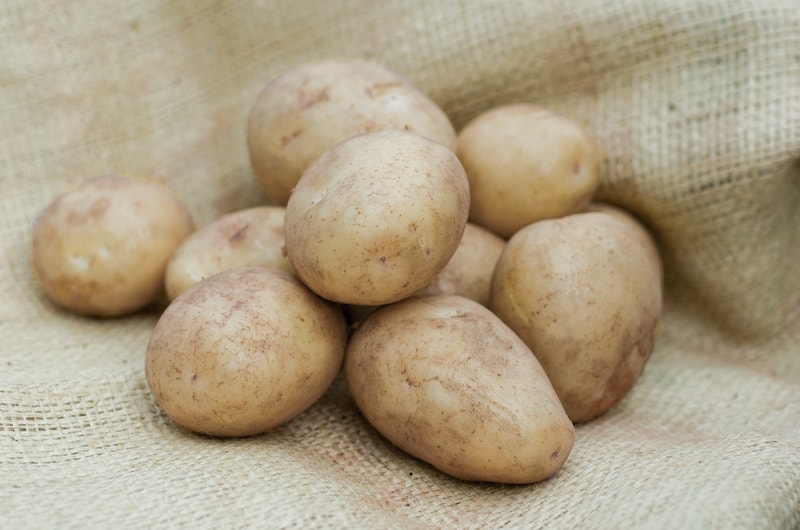
Growing your own potatoes allows you to try flavoursome varieties like ‘Casablanca’
Image: Seed potatoes organic ‘Casablanca’ from Suttons
There are four main varieties of potatoes which we grow here in the UK: first and second earlies; maincrop; and late season or second-cropping potatoes. As the names suggest, each has a slightly different growing season. First early varieties can be planted from February, while second croppers don’t go into the ground until about July.
Deciding which type to go for depends on what kind of potatoes you like to eat and the prevailing weather conditions where you live. If you like new potatoes, opt for first and second earlies. Lovers of a hearty roast potato should go for maincrop varieties, and if you want to feast on hot buttery spuds all winter long, you’ll be looking to get second croppers into the ground between June and late July.
That said, if you live in one of the warmer, wetter parts of the country, early varieties will probably work best for you. Blight is the potato’s nemesis – it thrives when the night time temperature rises above 10C and when warmer weather combines with lots of humidity. Blight can strike at any time, and can decimate a crop in days. The earlier you get your potatoes in the ground and harvested, the better chance you’ll avoid it.
What are first early potatoes?
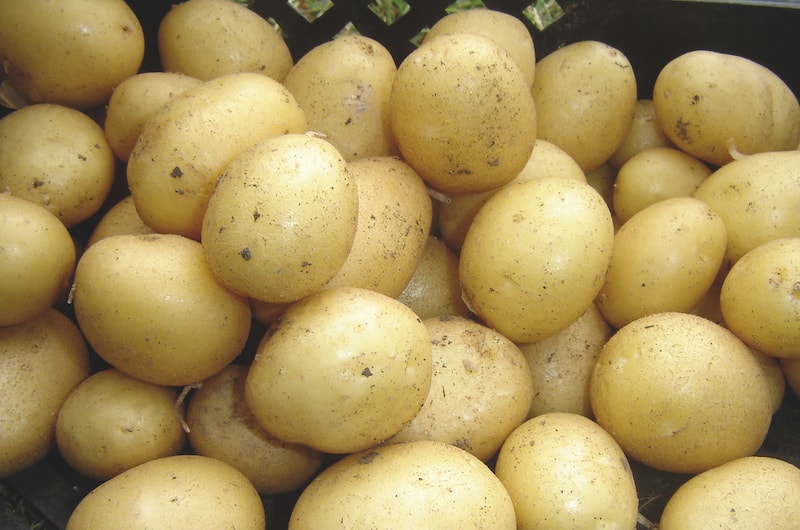
‘Rocket’ is a very early, heavy-cropping new potato
Image: Seed potato ‘Rocket’ from Suttons
First early seed potatoes like ‘Arran Pilot’ and ‘Maris Bard’ are commonly called ‘new’ potatoes and produce their harvest in June and July. You should be booking to get your chitted seed potatoes into the ground sometime between February and April, depending on the weather and when you want to harvest.
Taking just 9-13 weeks to grow, first early potatoes produce tasty tubers that have a white waxy flesh. They’re typically smaller potatoes and you should boil, steam or sauté them fresh from the ground – the flesh retains more of its natural sugars this way, tasting even sweeter and more delicious.
Plant first early potatoes to a depth of 10cm with at least 25-30cm between each potato, leaving 45cm between rows to give your plants enough room to grow and expand. Nine to 12 weeks later, you’ll notice flowers beginning to bloom. This indicates that the tubers have set and you can commence cropping. Dig a couple of plants to check on progress and then harvest as and when you fancy hot, buttered new potatoes for lunch or dinner.
What are second early potatoes?
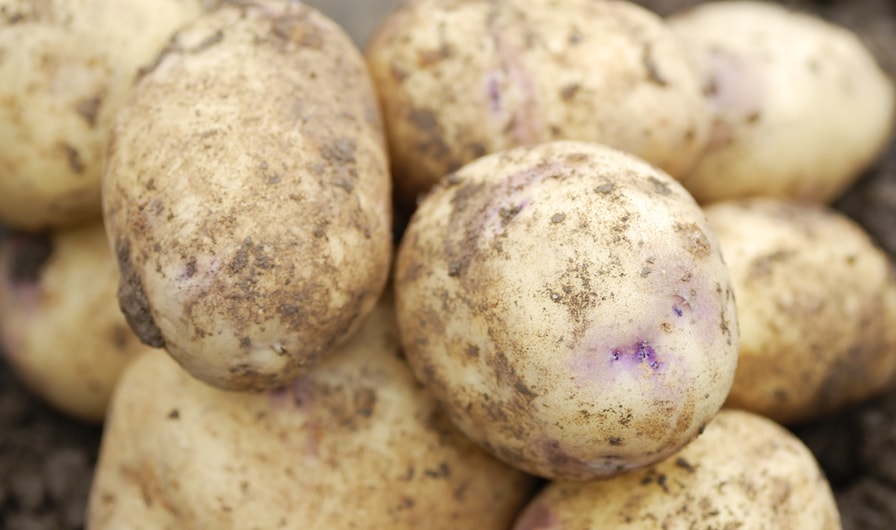
‘Kestrel’ is a good variety for the show bench
Image: Seed potato ‘Kestrel’ from Suttons
Second early seed potatoes like ‘Vivaldi’ and ‘Blue Belle’ are also classed as ‘new’ potatoes and only take a few weeks longer to mature than first earlies. Plant second earlies between March and April and aim to harvest 14-16 weeks later, in June through to September. Second earlies can be used as new potatoes, boiled, steamed, mashed or sauteed.
Second early seed potatoes need to be planted at a depth of 10cm with at least 30cm between each potato. There needs to be at least 45cm left between each row to give the plants enough room to grow and expand.
What are salad potatoes?
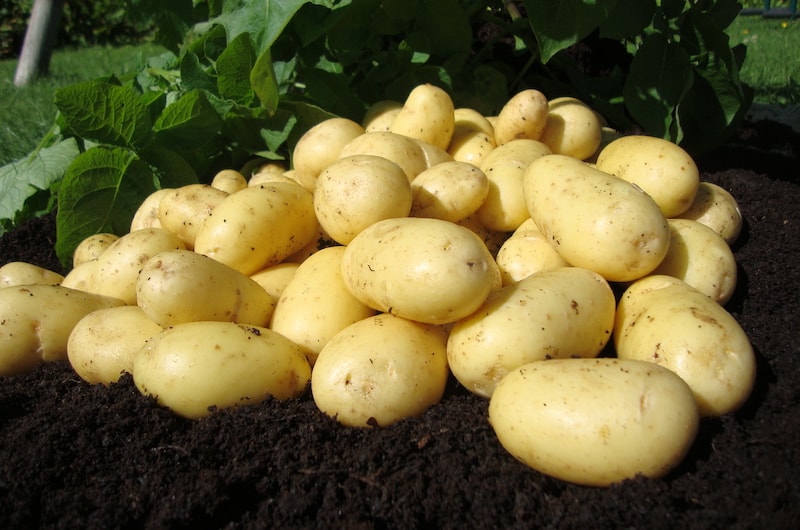
‘Charlotte’ is one of the most popular salad potato choices
Image: Seed potato ‘Charlotte’ from Suttons
Salad type seed potatoes are typically second early potatoes. They are planted between March and early May at a depth of 10cm with 30cm between each potato. There needs to be at least 45cm between each row to give the potato plants enough room to grow.
The most important ingredient in a potato salad is homegrown freshly-steamed salad potatoes. Try waxy varieties like Jazzy or Nicola, and do remember, the shorter the timeframe between harvesting and eating, the sweeter the flesh. When it comes to salad potatoes, growing your own is all about the taste advantage over store bought alternatives.
What are maincrop potatoes?

‘Desiree’ is a versatile red maincrop potato that is a great all-rounder
Image: Seed potato ‘Desiree’ (maincrop) from Suttons
Maincrop seed potatoes take longer to grow than first early and second early potatoes. Planted between March and early May, stalwart maincrop varieties like King Edward take 16-22 weeks to mature and are ready for harvesting between the end of August and October. If you’re happy to wait for big yields of delicious homegrown potatoes, maincrops are for you.
Maincrop potatoes produce tubers that are extremely versatile. They taste delicious mashed, boiled, steamed, roasted and baked, and are also great for making chips.
Plant main crop potatoes to a depth of 10cm with 40cm between each potato, leaving at least 70 to 75 cm between each row to give them plenty of space to grow. Open flowers (if present) indicate when the first tubers appear. This should occur around 14 weeks after planting. The potatoes should then be left for 4 to 8 weeks to allow the skin to harden so that they are able to store better.
What are late season potatoes?
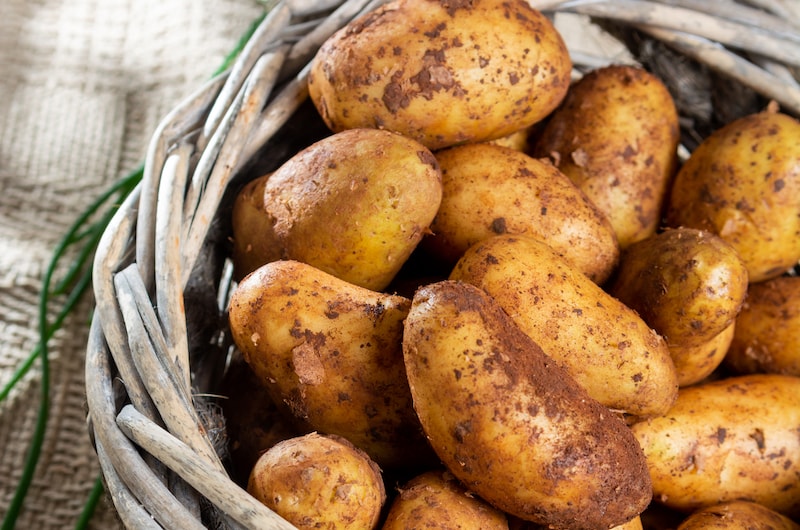
‘Nicola’ is a popular, smooth-skinned yellow potato with a great flavour
Image: Seed potatoes ‘Nicola’ (late season) from Suttons
Late season seed potatoes like Maris Peer and Nicola are commonly known as second-cropping potatoes and are grown for winter consumption. If you choose to grow these late season potatoes, you’ll be able to enjoy them from October all the way to Christmas Day!
Late season potatoes are grown from tubers that have been stored in a temperature controlled room, keeping them dormant until they’re ready to be planted between June and late July. Plant these seed potatoes as soon as they arrive so they can benefit from the warm summer soil where they’ll grow rapidly.
Follow the same planting instructions as main crop potatoes and you’ll be ready to harvest in October. Fancy freshly-harvested, buttery new potatoes with cold ham or turkey at your Christmas buffet? Simply leave some of your late crop in the ground until the big day.
We hope we’ve given you plenty of advice to help you choose the best potatoes for your needs. For more specific information on growing your own spuds, visit our guide on how to grow potatoes where you’ll find all the help and advice you need to grow a stupendous crop.
Lead images: Potato ‘Red Duke Of York’ from Suttons
Last Updated on December 3, 2025 by Suttons Horticultural Team

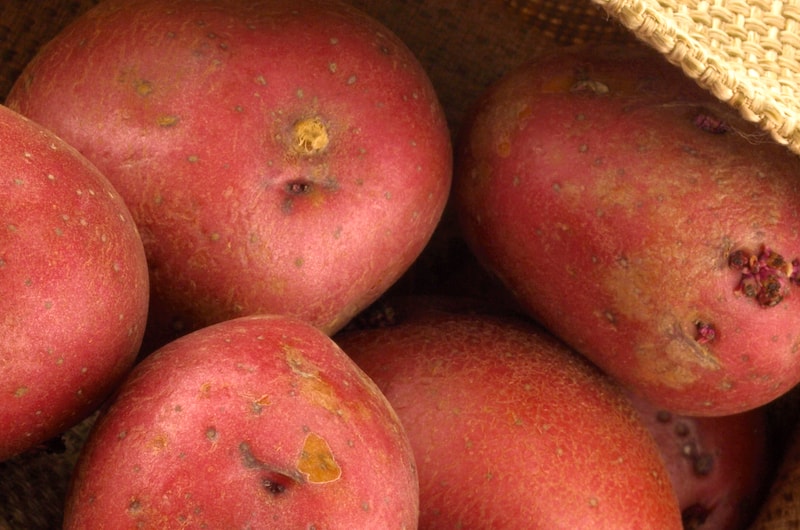

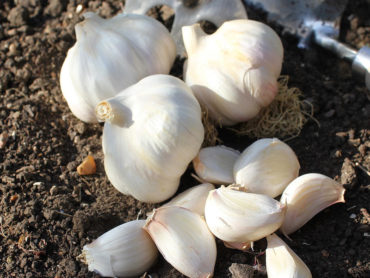

Hi there, do seed potatoes do well in containers I would like to try growing them in a container as my garden is on the small side.
Hi there, do seed potatoes do well in containers I would like to try growing them in a container as my garden is on the small.
We have maincrop potatoes that have grown randomly , obviously from our home made compost. We dug some and the tubers are small and sweet. However I noticed that the water that they were boiled in had a green tinge when strained although the potatoes did not have any green on them when they were harvested. I am concerned that they may not be safe to eat. I would appreciate your advice.
Many thanks
Sheila Coutanche
HI I would like to grow white sweet potatoes but I do not seem to find any at all do you have them if not Vivaldi as I want them for Christmas